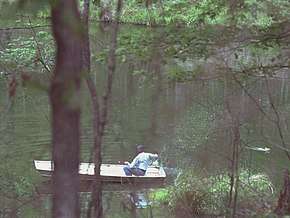Jimmy Carter rabbit incident
The Jimmy Carter rabbit incident, sensationalized as a "killer rabbit attack" by the press, involved a swamp rabbit that swam toward then–U.S. President Jimmy Carter's fishing boat on April 20, 1979. The incident caught the imagination of the media after Carter's press secretary, Jody Powell, mentioned the event to a correspondent months later.

Background
President Carter was fishing in his hometown of Plains, Georgia, on April 20, 1979, alone in a flat-bottomed boat while staff were on land nearby. Carter said a rabbit being chased by hounds "jumped in the water and swam toward my boat. When he got almost there, I splashed some water with a paddle."[1]
When Carter returned to his office, his staff did not believe his story, saying rabbits could not swim, or that one would never approach a person threateningly.[2] A White House photographer took a picture of the incident, which was released by a later administration.[3]
Media accounts and public perception
.jpg)
Associated Press correspondent Brooks Jackson's story on the incident was published August 30, 1979, in various newspapers, including on the front page of The Washington Post with the title "Bunny Goes Bugs: Rabbit Attacks President." The White House did not publicly release a photograph of the event until much later, and the Post printed a cartoon parody of the Jaws poster labeled "PAWS" as its illustration.[4][5][6] The White House declined to release the photo to the media until it turned up during the Reagan administration and the story saw a revival.
In his 1986 book The Other Side of the Story, Powell recounted the story:
Upon closer inspection, the animal turned out to be a rabbit. Not one of your cutesy, Easter Bunny-type rabbits, but one of those big splay-footed things that we called swamp rabbits when I was growing up.
The animal was clearly in distress, or perhaps berserk. The President confessed to having had limited experience with enraged rabbits. He was unable to reach a definite conclusion about its state of mind. What was obvious, however, was that this large, wet animal, making strange hissing noises and gnashing its teeth, was intent upon climbing into the Presidential boat.
The incident with the rabbit became fodder for political and ideological opponents who wanted to frame Carter's presidency as hapless and enfeebled,[7] although the event's proximity to the U.S. release of the comedy feature film Monty Python and the Holy Grail, which includes scenes of a killer rabbit slaying humans, led to some people describing Carter as having "fended off a killer rabbit" instead.
The incident was parodied in 1980 by folk singer Tom Paxton in the song "I Don't Want a Bunny Wunny." [8][9]
Humor columnist Dave Barry has often referred to the "enormous swimming rabbit" incident in his writings. In Dave Barry Slept Here: A Sort of History of the United States, he names it the uncontested single most memorable event of Carter's presidency.
See also
- Jimmy Carter UFO incident
- George H. W. Bush vomiting incident
- Bill Clinton haircut controversy
- Dick Cheney hunting incident
- Rabbit of Caerbannog
- Bush shoeing incident
References
- Combs, Cody (November 21, 2010). "Jimmy Carter explains 'rabbit attack'". Political Ticker. CNN.com. Retrieved 6 August 2015.
- "President Carter and the Killer Rabbit". American Presidents Blog. January 17, 2008. Retrieved 6 August 2015.
- "President Jimmy Carter and the "killer rabbit"". narsil.org. April 20, 1979. Retrieved August 6, 2015.
- "What was the deal with Jimmy Carter and the killer rabbit?". The Straight Dope. November 10, 1995. Retrieved August 6, 2015.
-
- Jackson, Brooks (August 30, 1979). "Bunny Goes Bugs: Rabbit Attacks President". Washington Post. Associated Press.
- Jackson, Brooks (August 30, 1979), "Jimmy's White House", Times-News, Hendersonville, North Carolina, Associated Press
- Zelizer, Julian E. (2010). "1: A Maverick Politician". Jimmy Carter. ISBN 9781429950756.
- "Jimmy Carter's 'Killer Rabbit' – 1979". Feeding Frenzy. The Washington Post. Retrieved August 6, 2015.
- Paxton, Tom. "I Don't Want a Bunny Wunny". Lyrics. www.mydfz.com.
- Paxton, Tom. "I Don't Want a Bunny Wunny". Full Song. www.youtube.com.
.jpg)
